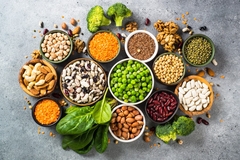
- Industry news
Industry news
- Category news
Category news
- Reports
- Key trends
- Multimedia
- Journal
- Events
- Suppliers
- Home
- Industry news
Industry news
- Category news
Category news
- Reports
- Key trends
- Multimedia
- Events
- Suppliers
Gene-edited poultry: Scientists breed resistant chickens to curb bird flu

11 Oct 2023 --- UK scientists are aiming to tackle one of the world’s most costly animal diseases, the bird flu, by using gene-editing techniques that recognize and modify parts of chicken DNA, to limit the spread of the potentially deadly virus in chickens. They have found a way to restrict, but not completely block, the virus from infecting the birds.
This comes at a time when the WHO, FAO and World Organization for Animal Health are urging nations to tackle the disease head-on following an outbreak in various hotspots around the world in recent years.
“Gene-editing offers a promising route toward permanent disease resistance, which could be passed down through generations, protecting poultry and reducing the risks to humans and wild birds,” says Professor Mike McGrew of the Roslin Institute, which has carried out the research.

“Our work shows that stopping the spread of avian influenza in chickens will need several simultaneous genetic changes.”
The study, published in Nature, points out that the obtained data illustrates a “first proof of concept” step to generate influenza A virus (IAV)-resistant chickens.
UK-based Roslin Institute, Imperial College London and the Pirbright have worked on the study to alter the DNA of the chickens to fight the disease.
“Although we haven’t yet got the perfect combination of gene edits to take this approach into the field, the results have told us a lot about how influenza virus functions inside the infected cell and how to slow its replication,” says Professor Wendy Barclay, of the Imperial College London.
The researchers note that the technique does not impact the birds’ health and well-being when genetic engineering is used to alter their DNA.
Testing the effectiveness
The scientists bred the chickens using gene editing techniques to alter the section of DNA responsible for producing a protein named ANP32A.
“When the ANP32A gene-edited chickens were exposed to a normal dose of the H9N2-UDL strain of avian influenza virus, commonly known as bird flu, nine out of ten birds remained uninfected and there was no spread to other chickens,” explain the researchers.
 The scientists bred the chickens using gene editing of the ANP32 gene family to create resistance to avian influenza (Image credit: Edinburgh University).The researchers further explored the impact of higher doses of the virus on the gene-edited birds, which led to five out of ten getting infected. This now calls for multiple genetic modifications to curtail the impact of higher doses of the virus on chickens.
The scientists bred the chickens using gene editing of the ANP32 gene family to create resistance to avian influenza (Image credit: Edinburgh University).The researchers further explored the impact of higher doses of the virus on the gene-edited birds, which led to five out of ten getting infected. This now calls for multiple genetic modifications to curtail the impact of higher doses of the virus on chickens.
However, the scientists observed that the amount of virus in the infected genetically modified chickens was much lower than in unmodified chickens, pointing toward some level of protection.
“The gene edit also helped to limit the onward spread of the virus to just one of four non-gene-edited chickens placed in the same incubator. There was no transmission to gene-edited birds," highlights the study.
Full immunity next?
The scientists say that the gene-edited chickens are not entirely immune to the bird flu, but their work hints at the possibility of achieving complete immunity in three years.
However, the findings demonstrate that the single ANP32A gene edit is not robust enough for application in the production of chickens, according to the team.
To prevent the emergence of escape viruses that still cause infection, the research team next targeted additional sections of DNA responsible for producing all three proteins, ANP32A, ANP32B and ANP32E, in the lab-grown chicken cells. These three gene edits successfully blocked the virus’ growth.
“The next step will be to try to develop chickens with edits to all three genes. No birds have been produced yet,” says the team.
Regarding their impact on humans, experts opine that additional genetic changes would be needed for the virus to infect and spread effectively in humans.
Animal well-being
While gene-editing is a way to curb bird flu, its role in animal well being needs to be explored too. Food Ingredients First spoke with Peter Stevenson, chief policy advisor, Compassion in World Farming (CIWF), who flags that bird flu’s pathogenicity went from low to high due to the crowded, stressful conditions inherent in industrial poultry production.
 CIWF says that bird flu intensified due to the crowded and stressful conditions in industrial poultry production.“Gene editing of poultry to make them more resistant to the current strain of bird flu is only masking the problem and not tackling the root cause of its spread.”
CIWF says that bird flu intensified due to the crowded and stressful conditions in industrial poultry production.“Gene editing of poultry to make them more resistant to the current strain of bird flu is only masking the problem and not tackling the root cause of its spread.”
“Factory farmed birds are kept in cramped, overcrowded conditions, often with poor hygiene, which is not only inhumane and the cause of great suffering, but it encourages viruses such as bird flu to spread easily and quickly.” He laments the fact that approximately 70% of chickens raised for meat globally are raised in intensive farming systems, with many bred to reach their slaughter weight in less than six weeks, half the time it would take traditionally.
He further warns that without taking urgent action and reforming the factory farming industry, the next outbreak will just be around the corner.
Gene-edited animals as food
Across the world, scientists are working to develop genetically engineered animals to confer disease resistance and enhance their productivity.
According to the Federation of American Scientists, the technique increases the growth rate of food animals.
For example, a company called AquaBounty has gene-edited salmon with a growth hormone gene from another fish species that reduces the time to reach market size to half, reducing production costs, feed requirements and waste generation. But there have been instances of such salmon escaping fish farms, posing ecological and genetic risks to their native counterparts.
Transgenic farm animals could also produce low-cholesterol eggs, reduced-lactose milk and low-fat meat.
Gene-editing has been used to breed animals that generate waste with low pollution-causing capability, too, such as Canada’s EnviroPig, which excretes less phosphorous in its feces.
By Insha Naureen











